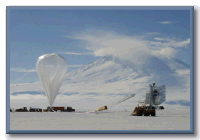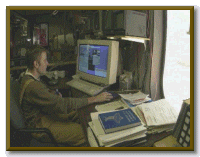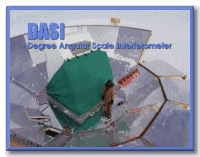In PASSPORT TO ANTARCTICA we showed you why this continent is such a good place to do astronomy. It's high and dry, so clouds don't interfere.
Recent experiments have taken full advantage both of the sky above, and the ice below. Using ice to look at the stars? You'll soon see how that works!
Most scientists now believe our universe began some 4.5 billion years ago in what's called the "Big Bang"-a tremendous explosion of energy from a point smaller than an atom.
There are still many mysteries about how a hot soup of subatomic particles became the galaxies, stars, and planets of today, but experiments here in Antarctica have greatly advanced our knowledge.
|
|
Image courtesy of NSF and NASA |
BOOMERANG
Balloon Observations Of Millimetric Extragalactic Radiation And Geophysics
"Boomerang" made its first flight in 1998. The gondola weighs 2 tons, but the huge helium-filled balloon carried its sensitive telescope 37 kilometers up into the sky! In the southern summer there's a constant wind circling the Pole. The balloon circumnavigated the continent in 10 and a half days and landed within 50 kilometers of its launch site! The results were published in April, 2000.
BOOMERANG provided a temperature map of the universe just 300,000 years after the "Big Bang." More recent research saw still finer detail.
|
CARA In PASSPORT TO ANTARCTICA we showed you "SPIREX", an infrared telescope, operated at the south pole by "CARA," the Center for Astrophysical Research in Antarctica.
Photographer Stephanie Rowatt, working with the CARA education office, took these great photos of astronomy and astronomers at the pole.
In 1999, SPIREX was retired and replaced by new telescopes, dedicated to the study of the early universe.
|
Images courtesy and |
Images courtesy and |
DASI "DASI" is really 13 exquisitely sensitive detectors operating in unison to make out incredibly fine detail. Tested back in Chicago, the 20,000 pound telescope was re-assembled at the South Pole. There was plenty of cabling, and computing, and physical labor to get it operating properly.
Some of the team wintered over, connected to the world by e-mail while living in cramped and spartan quarters. No wonder, silly hats sometimes appealed!
But the CARA astronomers were here to work. They added a series of petals to shield the telescope from radiation scattered back up from the ice. "DASI" was ready to bloom.
John Carlstrom led the team of hardy astronomers. DASI's results were announced in 2001. They confirmed and advanced the work of "BOOMERANG." These images showed just the kind of variations predicted by one leading theory of the early universe.
|
BOOMERANG and DASI revealed tiny temperature variations of 100 millionth of a degree Celsius, which may be the seeds of future galactic and cosmic structure. For all the difficulty of working at the Pole, the hard work paid off.
|
WANT TO LEARN MORE?
|
|
Websites
• Center for Astrophysical Research in Antarctica (CARA) The latest happenings at CARA and a virtural tour that takes you from New Zealand to the South Pole. • Degree Angular Scale Interferometer (DASI) Images and information on DASI • Balloon Observations Of Millimetric Extragalactic Radiation And Geophysics Homepage for the project where you can meet the team and see the latest images. • Virtual Tour - Infrared Images using the South Pole Infrared Explorer (SPIREX) • Astrophysics in Antarctica Background information on astrophysics in Antarctica including descriptions of current projects. |
![]()



